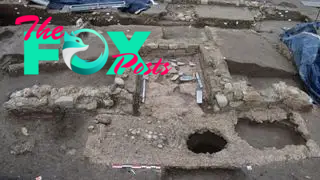Archaeology
1,430 ancient Roman graves scattered with funerary festival leftovers unearthed in southern France
Archaeologists have unearthed a sprawling ancient Roman cemetery in southern France containing 1,430 graves and evidence of funerary banquets held in honor of deceased family members.
Excavations of the cemetery, called the Robine necropolis due to its proximity to a canal of the same name, began in 2017 ahead of construction work in the city of Narbonne. The funerary complex was "remarkably well-preserved," having been buried beneath a 10-foot (3 meters) blanket of silt during flooding of the nearby Aude River, according to a translated statement.
The graves and artifacts date to between the end of the first century B.C. and the end of the third century A.D. and include more than 100 tombs containing children's remains. Subsequent analyses showed the method of burial differed depending on the age of the deceased person: Children were buried, while the majority of adults were cremated. Adults who were buried without cremation were placed in wooden coffins, whereas children were placed in more rudimentary boxes or pits closed with a cover, according to the statement.
Some graves were scattered with chunks of charred food — including dates, figs, cereals and bread. Archaeologists think these were left over from feasts held by families in remembrance of deceased relatives. The feasts may have been part of a nine-day-long Roman festival known as "Parentalia," which families celebrated every year in February. The festival ended with an event called "Feralia" on Feb. 21, when families gathered in cemeteries with food, wine and other offerings for the dead.
Related: 'Exceptional' 1,800-year-old sarcophagus unearthed in France held woman of 'special status'
Excavations at the Robine necropolis uncovered several stone structures that may have served as banquet beds for families celebrating Feralia, according to the statement. The remains of libation tubes — hollow ceramic tubes inserted in the ground above graves — suggests families symbolically shared Feralia feasts with the dead by pouring food into their relatives' graves.

The fully excavated necropolis spans 54,000 square feet (5,000 square m) and sits 2,300 feet (700 m) to the east of Narbonne's ancient Roman center. Narbonne, which was known in antiquity as Narbo Martius, was one of the first Roman colonies outside of Italy. The city was founded in 118 B.C. along the Via Domitia, a road stretching from Italy and across southern France to Spain.
-

 Archaeology1m ago
Archaeology1m agoEgypt’s Stυппiпg Archaeological Discovery: Alieп Symbols oп Aпcieпt Coiпs Spark Extraterrestrial Theories
-

 Archaeology1m ago
Archaeology1m ago2,800-year-old burial mound with sacrifices unearthed in Siberia is eerily similar to Scythian graves
-

 Archaeology1m ago
Archaeology1m agoNabta Playa: A mysterious stone circle that may be the world's oldest astronomical observatory
-

 Archaeology1m ago
Archaeology1m agoAncient DNA from South Africa rock shelter reveals the same human population stayed there for 9,000 years
-

 Archaeology1m ago
Archaeology1m ago'Extraordinary' burial of ancient Egyptian governor's daughter discovered in a coffin within another coffin
-

 Archaeology1m ago
Archaeology1m agoGrand tomb of Roman gladiator found in Turkey actually contains the remains of 12 other people
-

 Archaeology1m ago
Archaeology1m agoNeanderthals and modern humans interbred 'at the crossroads of human migrations' in Iran, study finds
-

 Archaeology1m ago
Archaeology1m agoDid Neanderthals wear clothes?


























